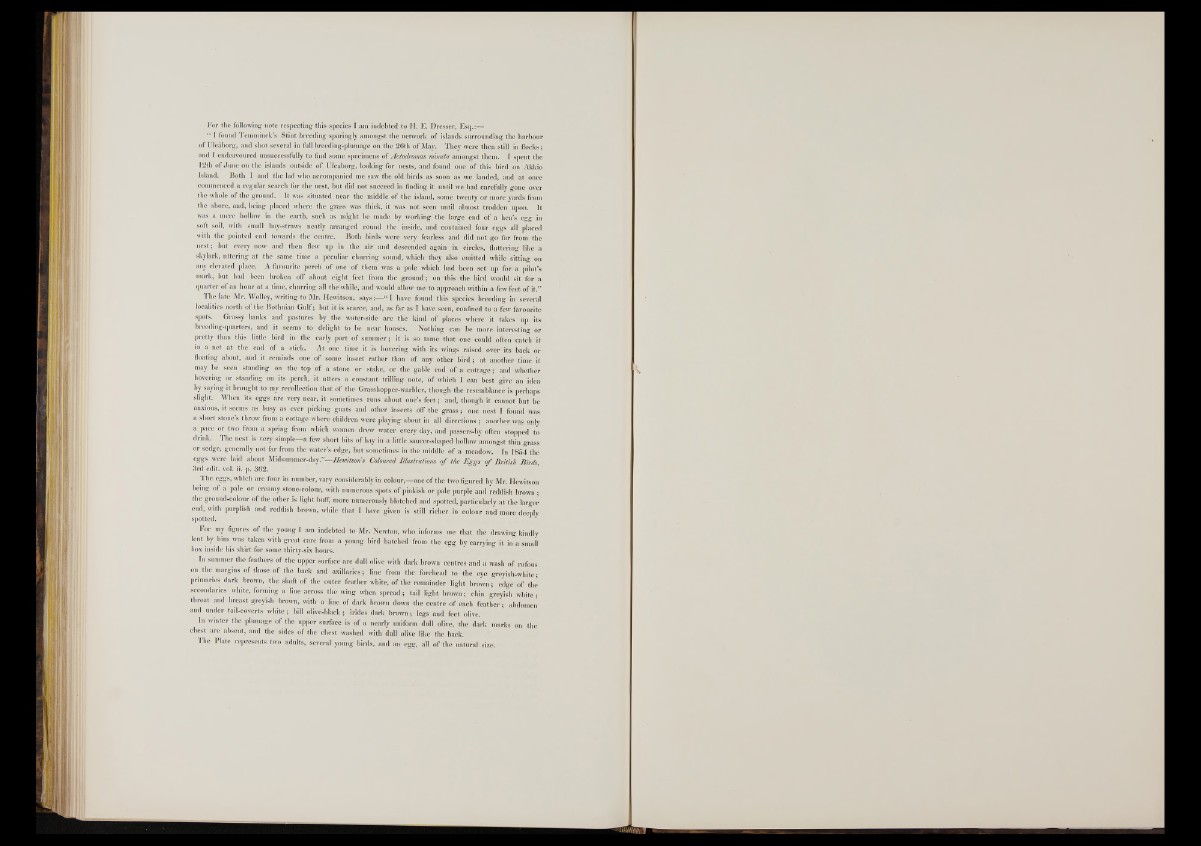
For the following note respecting this species I am indebted to H. E. Dresser, Esq. :—
“ I found Temminck’s Stint breeding sparingly amongst the network of islands surrounding the harbour
of Uleaborg, and shot several in full breeding-plumage on the 26th o f May. They were then still in flocks;
and I endeavoured unsuccessfully to find some specimens o f Actodromas minuta amongst them. I spent the
12th o f June on the islands outside o f Uleaborg, looking for nests, and found one o f this bird on Akkio
Island. Both I and the lad who accompanied me saw the old birds as soon as we landed, and at once
commenced a regular, search for the nest, but did not succeed in finding it until we had carefully gone over
the whole o f the ground. I t was situated near the middle of the island, some twenty or more yards from
the shore, and, being placed where the grass was thick, it was not seen until almost trodden upon. It
was a mere hollow in the earth, such as might be made by working the large end of a hen’s egg in
soft soil, with small hay-straws neatly arranged round the inside, and contained four eggs all placed
with the pointed end towards the centre. Both birds were very fearless and did not go far from the
nest; but every now and then flew up in the air and descended again in circles, fluttering like a
skylark, uttering at the same time a peculiar churring sound, which they also emitted while sitting on
any elevated place. A favourite perch of one of them was a pole which had been set up for a pilot’s
mark, but bad been broken off about eight feet from the ground; on this the bird would sit for a
quarter of an hour a t a time, churring all the while, and would allow me to approach within a few feet o f it.”
The late Mr. Wolley, writing to Mr. Hewitson, says:— “ I have found this species breeding in several
localities north o f the Bothnian Gulf; but it is scarce, and, as far as I have seen, confined to a few favourite
spots. Grassy banks and pastures by the water-side are the kind o f places where it takes up its
breeding-quarters, and it seems to delight to be near houses. Nothing can be more interesting or
pretty than this little bird in the early part o f summer; it is so tame that one could often catch it
in a net at the end o f a stick. At one time it is hovering with its wings raised over its back or
floating about, and it reminds one o f some insect rather than of any other b ird ; at' another time it
may be seen standing on the top o f a stone or stake, or the gable end o f a cottage ; and whether
hovering or standing on its perch, it utters a constant trilling note, of which I can best give an idea
by saying it brought to my recollection that of the Grasshopper-warbler, though the resemblance is perhaps
slight. When its eggs are very near, it sometimes runs about one’s f e e t; and, though it cannot but be
anxious, it seems as busy as ever picking gnats and other insects off the g ra s s ; one nest I found was
a short stone’s throw from a cottage where children were playing about in all directions ; another was only
a pace or two from a spring from which women drew water every day, and passers-by often stopped to
drink. The nest is very simple—a few short bits of hay in a little saucer-shaped hollow amongst thin grass
or sedge, generally not far from the water’s edge, but sometimes in the middle of a meadow. In 1854 the
eggs were laid about Midsnmmer-day.”—Hewitsoris Coloured Illustrations o f the E g g s o f British Birds,
3rd edit. vol. ii. p. 362.
The eggs, which are four in number, vary considerably in colour,—one of the two figured by Mr. Hewitson
being of a pale o r creamy stone-colour, with numerous spots o f pinkish or pale purple and reddish brown ;
the ground-colour of the other is light buff, more numerously blotched and spotted, particularly at the larger
end, with purplish and reddish brown, while that I have given is still richer in colour and more deeply
spotted.
For my figures of the young I ain indebted to Mr. Newton, who informs me that the drawing kindly
lent by him was taken with great care from a young bird hatched from the egg by carrying it in a small
box inside his shirt for some thirty-six hours.
In summer the feathers of the upper surface are dull olive with dark brown centres and a wash o f rufous
on the margins of those o f the back and axillariss.- line from the forehead to the eye greyish-white;
primaries dark brown, the shaft of the outer feather white, o f the remainder light brown; edge o f the
secondaries white, forming a line across the wing when sp re a d ; tail light brown; chin greyish wh ite;
throat and breast greyish brown, with a line of dark brown down the centre o f each fe a th e r; abdomen
and under tail-coverts w h ite ; bill olive-black; ¡rides dark brown; legs and feet olive.
In winter the plumage of the upper surfiice is o f a nearly uniform dull olive, the dark marks on the
chest are absent, and the sides of the chest washed with dull olive like the hack.
The Plate represents two adults, several young birds, and an egg, all o f the natural size.